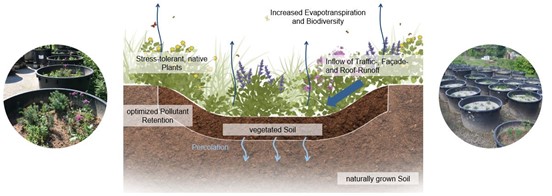Multifunctional infiltration swales in residential areas
Rapid urbanization is leading to high levels of densification in cities and new developments. The resulting increasing soil-sealing and reduction of inner-city green spaces inevitably leads to changes in the local water balance, intensification of effects such as the urban heat-island and a decline in biodiversity in settlement areas. Globally observed climate changes, including more frequent extreme events such as heavy rainfall and periods of drought, intensify the negative effects of a lack of open spaces in cities. An important element in counteracting these effects can be green infiltration swales in residential areas. In this research project, this type of near-natural stormwater-management is to be extended by the aspect of multifunctionality.
The aim is not only the development of an improved infiltration system, but also an optimized plant- and animal-habitat (cf. figure). The research on adapted and suitable vegetation is carried out by employees of the HSWT. The Chair of Urban Water Systems Engineering (SWW) focuses on the development of a suitable and optimized vegetated topsoil by means of substrate amendment. In the first half of 2021, the laboratory experiments on the retention of pollutants through different substrates were mainly completed. In July 2021, semi-technical experiments were set up open air with vegetation at both the HSWT and the SWW to investigate the material load and operational stability (cf. figure). This experiments at the SWW focuses on drainage safety and the retention of heavy metals and biocides from traffic-area-, facade- and roof-surface-runoff. In spring 2022, piloting in a residential area is planned with the proven soil-substrate mixtures and different plants from the semi-technical experiments. Additional observation of stormwater tree pits with the topsoil-substrate mixtures were done.
This research project forms the basis for a future guideline for operators and planners, from which the ecological and economic advantages, as well as the effort for maintenance, will become apparent.
The research project runs from November 2020 to September 2023.

| Project Leader | Prof. Dr. Brigitte Helmreich |
| Researcher | Philipp Stinshoff, M.Sc. |
| Funding | Bayerisches Staatsministerium für Umwelt und Verbraucherschutz (StMUV) |
| Project Partners |